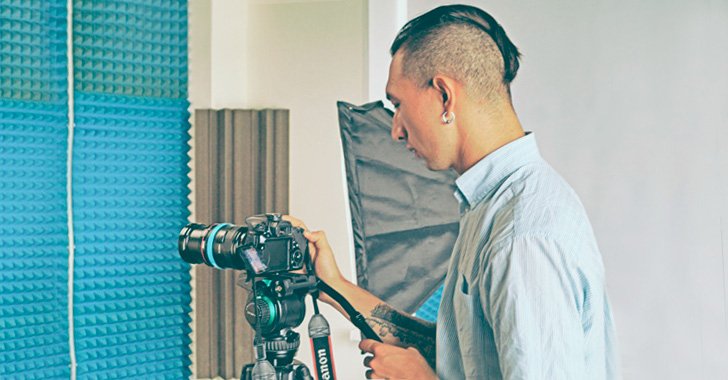We use cookies to improve the services we offer you. By continuing to browse this site, you consent to keep them in accordance with our Privacy Policy.
×We use cookies to improve the services we offer you. By continuing to browse this site, you consent to keep them in accordance with our Privacy Policy.
× 5,950
5,950
 9 min
9 min

Human progress can’t be stopped and, in many areas of public life, people are always looking for new ways to develop. For example, because social networks are now an essential part of our lives, suppliers of goods and services have to create Social Media Marketing (SMM) departments to keep up with their customers. Recently, we spoke with Roman Zhayvoron, the head of SMM at Movavi, an international software development company. We talked specifically about how to develop a corporate YouTube channel, how to produce videos, and the strategies to focus on if you want to promote your business through YouTube.
We work in the format of a weekly blog – I would call it a “YouTube Show.” We need to release one video per week, but in reality it doesn’t always happen that way. As we always choose different topics for our videos, there can be different situations. For example, we can work on one issue for three days, and on another one for eight days. We always want to please different audiences and make sure that our viewers don’t get bored. Our main aim is to attract new viewers to the channel, so the process of creating a video also includes planning for what videos to make next. This planning can take from one to two months. We usually write scripts for our videos in advance. Also, normal business has to go on in parallel with the main creative process. On average, each video takes a few weeks to produce. Of course, it’s all very individual, and depends on a huge number of factors.
Theoretically, it could happen, but it’s never happened to us – yet! It’s always better to plan in extra time in case of force majeure, so you can feel more comfortable about being able to deliver on time. As an option, you can make what we call “blanks” – ready-made videos that you can post any time. You can also use a Youtube scheduler in order to have your videos prepared ahead. Of course, you lose flexibility and the ability to respond to some newsbreaks. But if it doesn’t spoil the concept of your channel – well done!

Some people might find this surprising, but writing a script often takes the most time. First you need to choose a topic and then collect all the necessary information about it. Our goal is to give our audience something valuable, that is a living, interesting, and above all relevant “product”. The information for the script needs to be researched, then organized into a single coherent document. After that, the document needs to be structured, translated into “video language”, and prepared for filming.
At the script creation stage, the team is engaged in the research, collection and analysis of information. Then we have a brainstorming session when the team cuts out the excess, starts to convert the accumulated information to a narrative, and makes editorial corrections. As for the technical details of the shoot, in our videos we use voice-over technology: the presenter records his or her voice using a microphone, and the team comes up with how it’ll be illustrated by the video. Generally, at this stage, the more informational part of the text is recorded. Also, there’s one more part of the video, that we call “standup” – this is when the presenter is on camera. In this part of the shoot, we usually use less informational text so we can emotionally communicate with the viewer. This is like giving the channel a personality. After that we move on to the video editing process.
We have a fairly small team that consists of five people: two editors, one channel manager, one presenter, and one team leader – that’s me. Our editors have higher education in their field, which helps our tea, a lot. The manager monitors the channel, responds to comments and, in particular, promotes the channel. I head the team and do everything and anything: video recording, editing and writing scripts. There isn’t a dedicated screenwriter on our team. I graduated from the Faculty of Philology, and that helps me – I’m trusted to write the scripts. In general, we try to work on tasks together as a team.

For a long time, only one person worked on the channel. He also managed the company’s accounts on Twitter and Facebook. About two years ago the company decided to create a separate team for the development of the YouTube channel. At first it was just me. One of the most common problems at the outset of any YouTube project is how to get those first thousand subscribers. Luckily for me, at that time, the channel already had about two thousand subscribers. Two years ago another guy joined the team, and then another. As a result, it’s all turned into a cross-functional team of five people.
Your workflow will always depend on the goals you set and the channel format you choose for yourself. One of the main advantages of YouTube is that it doesn’t work according to the usual laws of television and advertising. You can promote your channel on YouTube without a huge financial or professional investment. You can begin with simple enough content. The most important thing is to be useful to your audience. It often happens that you see a channel with hundreds of thousands of subscribers, but you have no idea why its content works. The reality is that you’re outside of that particular box. The person who runs that channel has found his or her niche.
The promotion you do depends on your goals. Remember the old parable of the blind men and the elephant? It’s the same thing. Someone thinks that YouTube is a new platform for SMM, another thinks that YouTube is the television of the twenty-first century, and for a third person, YouTube is an advertising platform. All of these classifications can be true, at least in terms of the aims of your business. When someone asks me: “How do I monetize my YouTube channel?”, I tell them that there are three main options. First of all, you can start your business on YouTube as an advertiser. For this purpose, YouTube is perfect. You can set up your own advertising campaign using Google Ads (a contextual advertising service from Google – editorial note.)

Yes, you do. It’s important to understand that making a video from scratch won’t work, because Google has specific requirements for the video content. Your videos will appear in the search results and your short clips will be played before other videos. In fact, it’s like any advertising, only on YouTube. The costs will be roughly similar to the budget for a typical advertising campaign. Most likely, you’ll need the help of a professional production studio.
The second way is to become a YouTube blogger and start your own YouTube channel. Unlike other social networks, the YouTube algorithm is very good at separating advertising from non-advertising content. It would be very difficult for you to make an exclusively commercial channel – for a start, it isn’t useful for subscribers. You have to live in this digital “jungle” under the same law as all other YouTube bloggers, so you have to find your audience and offer them something exceptionally interesting. It’s very important to indulge their whims.
And the third option is native advertising (a type of advertising, mostly online, that matches the form and function of the platform upon which it appears – editorial note.) You ask bloggers to mention your product or brand in their videos. This isn’t the insertion of an incidental clip by Google Ads or YouTube – it’s when the presenter personally advertises your product. You can search for these kinds of channels yourself or you can hire someone to look for suitable opportunities on special ad exchanges and offer bloggers the chance to advertise your product or brand.
Before creating a YouTube channel, you should study the basic “YouTube alphabet.” We have a number of tutorial videos on our channel. You’ll learn how to set up your own YouTube channel, why you need to insert active links at the end of your videos, how to write the description under the video, how video tags work on YouTube, and how to come up with good names for your videos.